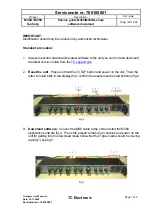
1-7
Nonetheless, MPLS can easily implement the seamless integration between IP networks and Layer 2
networks of ATM, frame relay, and the like, and offer better solutions to Quality of Service (QoS), TE,
and VPN applications thanks to the following advantages.
MPLS-based VPN
Traditional VPNs depend on tunneling protocols such as GRE, L2TP, and PPTP to transport data
between private networks across public networks, while an LSP itself is a tunnel over public networks.
Therefore, implementation of VPN using MPLS holds natural advantages.
An MPLS-based VPN uses LSPs to connect geographically dispersed branches of an organization to
form a united network. MPLS-based VPN also supports the interconnection between VPNs.
Figure 1-6
MPLS-based VPN
CE 1
PE 1
PE 3
CE 3
PE 2
CE 2
VPN 1
VPN 2
VPN 3
MPLS backbone
Figure 1-6
shows the basic structure of an MPLS-based VPN. Two of the fundamental components are
customer edge device (CE) and service provider edge router (PE). A CE can be a router, switch, or host.
All PEs are on the backbone network.
PEs are responsible for establishing LSPs between them, managing VPN users, and advertising routes
among different branches of the same VPN. Route advertisement among PEs is usually implemented
by LDP or extended BGP.
MPLS-based VPN supports IP address multiplexing between branches and interconnection between
VPNs. Compared with a traditional route, a VPN route requires the branch and VPN identification
information. Therefore, it is necessary to extend BGP to carry VPN routing information.
MPLS-based TE
MPLS-based TE and the Diff-serv feature allow not only high network utilization, but also different levels
of services based on traffic precedence, providing voice and video streams with services of low delay,
low packet loss, and stable bandwidth guarantee.
As TE is more difficult to be implemented on an entire network, the Diff-serv model is often adopted in
practical networking schemes to implement QoS.
The Diff-serv model maps a service to a certain service class at the network edge according to the QoS
requirement of the service. The DS field (derived from the ToS field) in the IP packet identifies the
service class uniquely. Then, each node in the backbone network performs the preset service policies
according to the field to ensure the corresponding QoS.
Содержание S7902E
Страница 82: ...1 4 DeviceA interface tunnel 1 DeviceA Tunnel1 service loopback group 1 ...
Страница 200: ...1 11 DeviceB display vlan dynamic No dynamic vlans exist ...
Страница 494: ...ii Displaying and Maintaining Tunneling Configuration 1 45 Troubleshooting Tunneling Configuration 1 45 ...
Страница 598: ...ii ...
Страница 1757: ...4 9 ...
Страница 1770: ...6 4 ...
Страница 2017: ...2 11 Figure 2 3 SFTP client interface ...
Страница 2062: ...i Table of Contents 1 URPF Configuration 1 1 URPF Overview 1 1 What is URPF 1 1 How URPF Works 1 1 Configuring URPF 1 2 ...
Страница 2238: ...1 16 DeviceA cfd linktrace service instance 1 mep 1001 target mep 4002 ...
Страница 2442: ...2 4 Set the interval for sending Syslog or trap messages to 20 seconds Device mac address information interval 20 ...
















































